
The Burlington Northern Santa Fe (BNSF) Railway Company is the largest freight railroad network in North America. One of seven North American Class I railroads, BNSF has 41,000 employees, 32,500 miles (52,300 km) of track in 28 states, and more than 8,000 locomotives. It has three transcontinental routes that provide rail connections between the western and eastern United States. BNSF trains traveled over 169 million miles in 2010, more than any other North American railroad.

The Atchison, Topeka and Santa Fe Railway, often referred to as the Santa Fe or AT&SF, was one of the larger railroads in the United States. The railroad was chartered in February 1859 to serve the cities of Atchison, Kansas, Topeka, Kansas, and Santa Fe, New Mexico. The railroad reached the Kansas–Colorado border in 1873 and Pueblo, Colorado, in 1876. To create a demand for its services, the railroad set up real estate offices and sold farmland from the land grants that it was awarded by Congress.

A reefer ship is a refrigerated cargo ship, typically used to transport perishable commodities which require temperature-controlled transportation, such as fruit, meat, fish, vegetables, dairy products and other items .
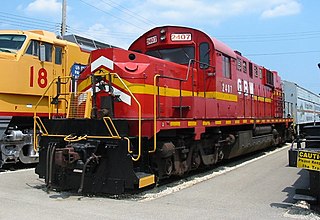
The Green Bay and Western Railroad served central Wisconsin for almost 100 years before it was absorbed into the Wisconsin Central in 1993. For much of its history the railroad was also known as the Green Bay Route. At the end of 1970 it operated 255 miles of road on 322 miles of track; that year it reported 317 million ton-miles of revenue freight.
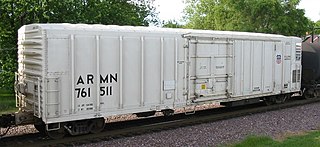
A refrigerator car is a refrigerated boxcar (U.S.), a piece of railroad rolling stock designed to carry perishable freight at specific temperatures. Refrigerator cars differ from simple insulated boxcars and ventilated boxcars, neither of which are fitted with cooling apparatus. Reefers can be ice-cooled, come equipped with any one of a variety of mechanical refrigeration systems, or utilize carbon dioxide as a cooling agent. Milk cars may or may not include a cooling system, but are equipped with high-speed trucks and other modifications that allow them to travel with passenger trains.

The Bangor and Aroostook Railroad was a United States railroad company that brought rail service to Aroostook County in northern Maine. Brightly painted BAR box cars attracted national attention in the 1950s. First-generation diesel locomotives operated on BAR until they were museum pieces. The economic downturn of the 1980s coupled with the departure of heavy industry from northern Maine forced the railroad to seek a buyer and end operations in 2003.
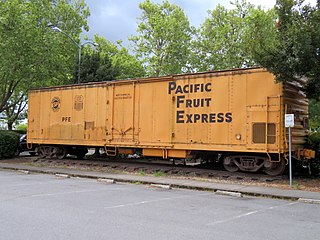
Pacific Fruit Express was an American railroad refrigerator car leasing company that at one point was the largest refrigerator car operator in the world.

The Portland and Western Railroad is a 466-mile (750 km) Class II railroad serving the U.S. state of Oregon, and is a wholly owned subsidiary of shortline and regional railroad holding company Genesee & Wyoming Inc. The PNWR includes a subsidiary, the Willamette and Pacific Railroad.
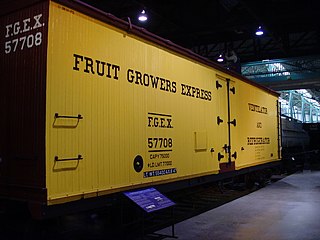
Fruit Growers Express (FGE) was a railroad refrigerator car leasing company that began as a produce-hauling subsidiary of Armour and Company's private refrigerator car line. Its customers complained they were overcharged. In 1919 the Federal Trade Commission ordered the company's sale for antitrust reasons.

The Santa Fe Refrigerator Despatch was a railroad refrigerator car line established as a subsidiary of the Atchison, Topeka and Santa Fe Railway in 1884 to carry perishable commodities. Though the line started out with a mere 25 ventilated fruit cars and 8 ice-cooled refrigerator cars, by 1910 its roster had swollen to 6,055 total units.
Burlington Refrigerator Express (BREX) was a railroad refrigerator car leasing company that was formed on May 1, 1926 as a joint venture between the Chicago, Burlington and Quincy Railroad (CB&Q) and the Fruit Growers Express Company. The move helped the FGE expand its business into the Pacific Northwest, and added almost 2,700 ice bunker units to the existing car pool already under lease by the Burlington to the FGE and Western Fruit Express (WFE).

Western Fruit Express (WFE) was a railroad refrigerator car leasing company formed by the Fruit Growers Express and the Great Northern Railway on July 18, 1923 in order to compete with the Pacific Fruit Express and Santa Fe Refrigerator Despatch in the Western United States. The arrangement added 3,000 cars to the FGE's existing equipment pool. It is now a wholly owned subsidiary of the Burlington Northern Santa Fe Corporation (BNSF), the Great Northern's successor. The success of the WFE led to the creation of the Burlington Refrigerator Express (BREX) in May 1926.
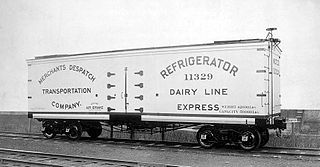
The Merchants Despatch Transportation Company was established in 1857 or 1858 by the American Express Company of New York. The entity was reformed as a joint stock trading company on June 1, 1869, with ownership divided among the Cleveland, Columbus, Cincinnati and Indianapolis Railway (CCC&I), the Lake Shore and Michigan Southern Railway, and the New York Central Railroad (NYC), all part of the Cornelius Vanderbilt rail empire.

The Armour Refrigerator Line was a private refrigerator car line established in 1883 by Chicago meat packer Philip Armour, the founder of Armour and Company.

The St. Louis Refrigerator Car Company (SLRX) was a private refrigerator car line established on February 3, 1878, by Anheuser-Busch, the brewer's first subsidiary. SLRX was formed to facilitate large-scale distribution of the A-B's products via the U.S. rail network. The SLRX not only built its own bunkerless reefers, but maintained and operated them as well.

The American Refrigerator Transit Company (ART) was a St. Louis, Missouri-based private refrigerator car line established in 1881 by the Missouri Pacific and Wabash railroads. It is now a subsidiary of the Union Pacific Corporation.

The Union Refrigerator Transit Line (URT) was a St. Louis, Missouri- and Milwaukee, Wisconsin-based private refrigerator car line established in 1895 by the Joseph Schlitz Brewing Company. In 1929, the General American Tank Car Corporation acquired the URT and placed its rolling stock into lease service. In the early 1970s the company, then operating as the General American Transportation Corporation (GATX) liquidated its URT subsidiary along with its outdated wooden reefer fleet.
The North Western Refrigerator Line (NWX) was a Chicago, Illinois-based private refrigerator car line established in 1924, one of the last such companies to be formed. Between 1924 and 1940 the company acquired more than 3,000 new wood refrigerator cars originally built by the American Car and Foundry Company, and leased the former Ringling Brothers Circus railroad car plant in Baraboo, Wisconsin to serve as a car shop.
















